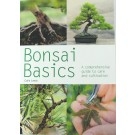Establishing Your Indoor Bonsai
Plants have simple needs. Provide these and your bonsai will out live you! Light + air + water + a little nutrient very rarely. Get these in the right balance and your bonsai tree will be very happy. Fail to provide these simple needs and you will fail. Bonsai do not die they are killed by inexperience!
Our trees are kept in a greenhouse. Because of this the tree has been acclimatised to a humid environment, the opposite to a modern home. The species used for indoor bonsai are tough and very adaptable, so with a little care your tree will be growing happily again within a few weeks. Upon arrival unpack your tree carefully and firm it gently into the pot as it may have become loose in transit.
Placement
We recommend a bright spot for indoor bonsai, a conservatory is ideal. Failing that a bright window-sill that does not have a heater beneath it. All species of indoor bonsai need a cool period over winter to rest, this may be difficult to achieve in most modern homes. Once you find a suitable place, leave your tree there. Bonsai do not like being moved from place to place.
Watering
Watering bonsai is a very skilled thing to do. In our experience EVERYONE gets it wrong at the outset, some people never master it even after decades. Insufficient watering can kill your tree in 24 hours! However watering is simple. Roots need air as well as water. The act of watering not only supplies water to the plant but air to it’s roots thus giving the tree just what it needs to remain healthy. In order to maximise this effect it is desirable to allow the trees rootball to just barely begin to dry out between watering. However if the tree begins to wilt you have waited too long. If the trees soil is cold and damp to the touch hold off watering for a little longer. To help learn about watering bonsai we recommend allowing a weed to grown in the pot. Once the weed BEGINS to wilt it’s time to water, simple!
BE AWARE THAT THE ROOTBALL NEEDS TO BE SOAKED THROUGH. JUST WETTING THE TOP ½" OF SOIL WILL KILL YOUR TREE. IF IN DOUBT SUBMERGE THE ROOTBALL IN WATER FOR 10 MINUTES TO ENSURE IT IS FULLY SOAKED THROUGH.
Watering is determined by the rate of use and evaporation. Watering frequency is therefore not determined by the clock but by the needs of the plant. In summer it may be necessary to water several times a day but in winter it MIGHT not need watering for weeks at a time dependant upon prevailing conditions.
Foliage
A plants foliage grows to suit the environment in which it forms. When moved to a different environment it is possible that the leaves will quickly turn yellow and drop. Eventually the tree will begin to grow again. Timing is dependant upon the conditions in which it is kept. The new foliage will be adapted to the trees position. As the new leaves become old they too will fall and be replaced by new. Yellowing leaves can also be a sign of over-watering. Evergreen bonsai shed leaves at various times of year, these turn yellow before dropping. Brown leaves are a sign of chronic dehydration caused by a lack of water or excess fertilizer.
Fertilizer
 Never fertilize a plant that is not actively growing. Once you see new leaves emerging you can begin to fertilize.
Never fertilize a plant that is not actively growing. Once you see new leaves emerging you can begin to fertilize.
New Growth
If the new growth that your tree makes is long and spindly with large gaps between the leaves this is because it is either too warm or not receiving enough light.
If new growth browns off quickly you are under watering or the position is too hot (like over a radiator).
If new growth turns black or collapses soon after emerging it’s likely you are overwatering.
For more excellent information on keeping bonsai see Bonsai Basics Book, an exceptional little book available for just £5.99.

